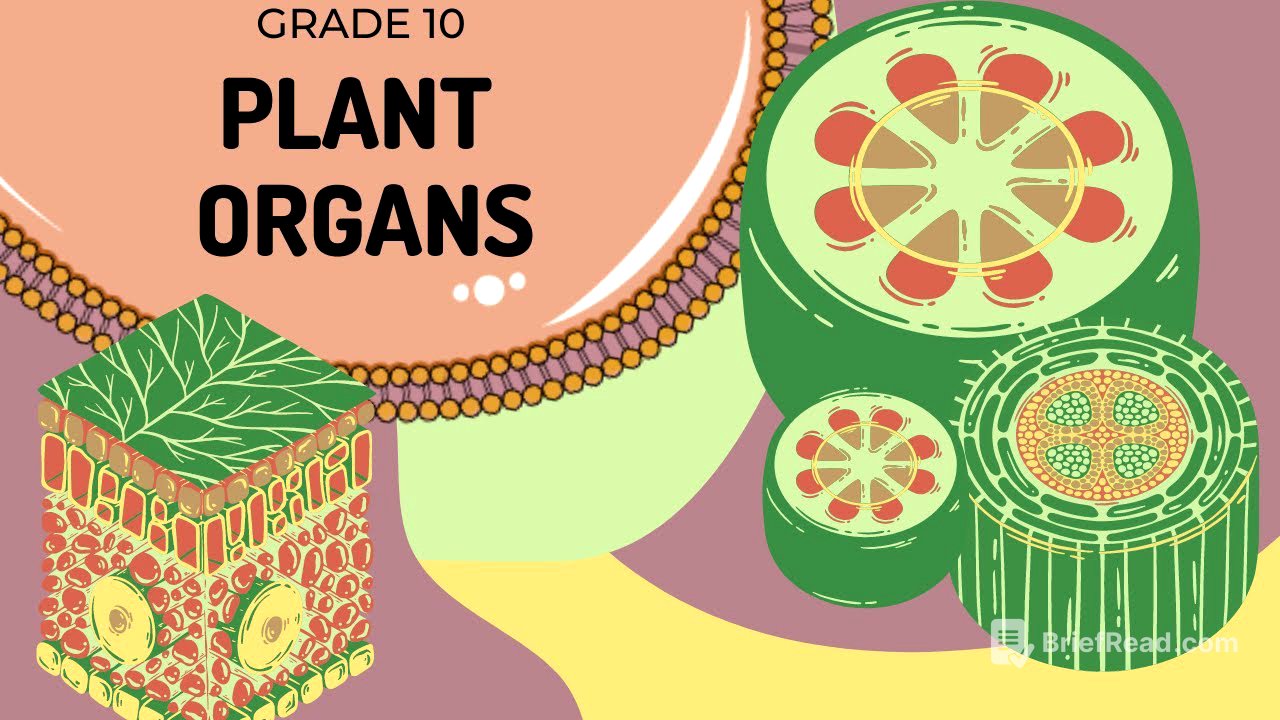TLDR;
This video by Miss Angler provides a detailed overview of plant organs, focusing on leaves, stems, and roots. It explains the different tissue types found in each organ, including dermal, vascular, and ground tissues, and their specific functions. The video also covers specialised structures like stomata, root hairs, and the casparian strip, highlighting their roles in photosynthesis, water absorption, and transport.
- Plant organs are made up of different tissues working together.
- Leaves are responsible for photosynthesis, stems provide support and transport, and roots anchor the plant and absorb water and minerals.
- Dermal, vascular, and ground tissues are present in all plant organs, but their specific arrangements and functions vary.
Introduction to Plant Organs [0:01]
Miss Angler introduces the topic of plant organs, highlighting the importance of understanding plant tissues before proceeding. The video will explore the structures and functions of leaves, stems, and roots, which are divided into the shoot system (above ground) and the root system (below ground). It's important to recognise the differences in tissue roles above and below ground.
Recap of Plant Tissues [1:12]
The video recaps the three main tissue types: dermal, vascular, and ground tissues. Dermal tissues cover the outside of the plant, providing protection and sometimes specialising into structures like stomata. Vascular tissues, consisting of xylem (for water transport) and phloem (for food transport), provide structure, support, and transportation. Ground tissues, including parenchyma, collenchyma, and sclerenchyma, form the building blocks of the plant, providing packaging, structural support, and connective tissue.
Leaf Structure and Function [4:08]
Leaves are described as solar panels, trapping sunlight for photosynthesis. The structure of a leaf is examined, starting with the cuticle, a see-through, waterproof covering that prevents water loss while allowing sunlight to pass through. Below the cuticle is the epidermis, a protective layer one cell thick. The mesophyll, consisting of palisade and spongy cells, is where photosynthesis occurs. Palisade cells are elongated and packed with chloroplasts, while spongy cells are irregularly shaped and facilitate water and gas exchange. Vascular tissues (xylem and phloem) run through the veins, transporting water and products of photosynthesis. The underside of the leaf features the lower epidermis and cuticle, along with stomata, modified epidermal cells that regulate gas exchange and water release.
Stem Structure and Function [9:23]
The video focuses on dicot stems, identifiable by their cylindrical shape and vascular bundles arranged in a circle. The epidermis is the outermost layer, sometimes containing chloroplasts. The cortex, the filling of the stem, may contain collenchyma, which, if it has chloroplasts, is called chlorenchyma, giving the stem a green colour. Vascular bundles, containing xylem and phloem, are responsible for conducting water and nutrients. Phloem is located on the outside of the bundle, while xylem is on the inside. The cambium, a meristematic tissue, allows the stem to grow and widen. The pith, located in the centre of the stem, is composed mostly of ground tissue, such as parenchyma.
Root Structure and Function [13:59]
Roots are specialised organs for anchoring the plant and absorbing water and minerals. Root hairs increase the surface area for absorption. Root hairs lack a cuticle to maximise water absorption. The cortex layer, made up of ground tissues like parenchyma and collenchyma, lies beneath the root hairs. The endodermis, an inner skin-like layer, funnels water towards the core of the root. The casparian strip, a waterproof layer within the endodermis, ensures water is directed to the xylem. Xylem and phloem are located in the centre of the root, with phloem in the centre and xylem around the edges. The pericycle and vascular cambium are responsible for growth and the production of more vascular tissue.
Terminology Recap [19:12]
Miss Angler provides a terminology recap, defining key terms such as epidermal tissue, ground tissue, vascular tissue, cuticle, mesophyll, parenchyma, collenchyma, sclerenchyma, cortex, cambium, pericycle, endodermis, casparian strip, root hairs, and stomata. These definitions reinforce the concepts covered in the video and provide a useful study aid.









